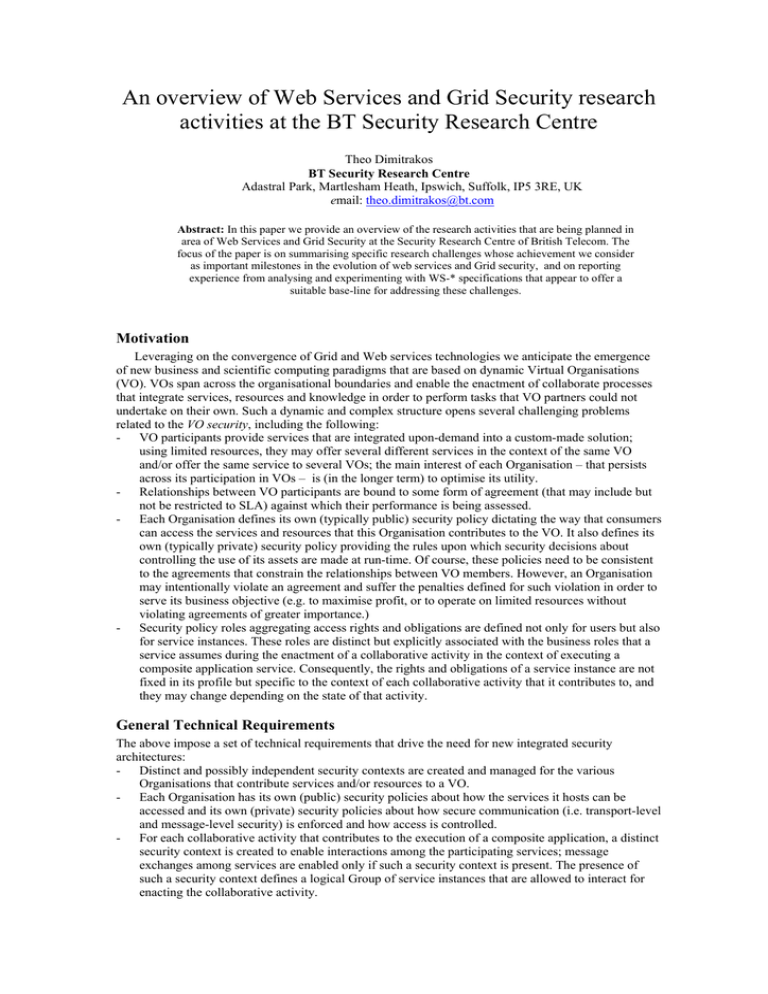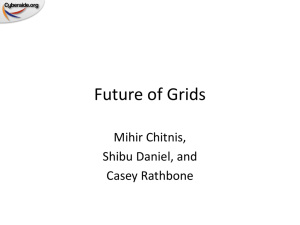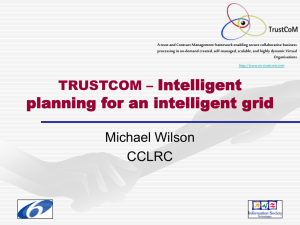An overview of Web Services and Grid Security research Theo Dimitrakos
advertisement

An overview of Web Services and Grid Security research activities at the BT Security Research Centre Theo Dimitrakos BT Security Research Centre Adastral Park, Martlesham Heath, Ipswich, Suffolk, IP5 3RE, UK email: theo.dimitrakos@bt.com Abstract: In this paper we provide an overview of the research activities that are being planned in area of Web Services and Grid Security at the Security Research Centre of British Telecom. The focus of the paper is on summarising specific research challenges whose achievement we consider as important milestones in the evolution of web services and Grid security, and on reporting experience from analysing and experimenting with WS-* specifications that appear to offer a suitable base-line for addressing these challenges. Motivation Leveraging on the convergence of Grid and Web services technologies we anticipate the emergence of new business and scientific computing paradigms that are based on dynamic Virtual Organisations (VO). VOs span across the organisational boundaries and enable the enactment of collaborate processes that integrate services, resources and knowledge in order to perform tasks that VO partners could not undertake on their own. Such a dynamic and complex structure opens several challenging problems related to the VO security, including the following: - VO participants provide services that are integrated upon-demand into a custom-made solution; using limited resources, they may offer several different services in the context of the same VO and/or offer the same service to several VOs; the main interest of each Organisation – that persists across its participation in VOs – is (in the longer term) to optimise its utility. - Relationships between VO participants are bound to some form of agreement (that may include but not be restricted to SLA) against which their performance is being assessed. - Each Organisation defines its own (typically public) security policy dictating the way that consumers can access the services and resources that this Organisation contributes to the VO. It also defines its own (typically private) security policy providing the rules upon which security decisions about controlling the use of its assets are made at run-time. Of course, these policies need to be consistent to the agreements that constrain the relationships between VO members. However, an Organisation may intentionally violate an agreement and suffer the penalties defined for such violation in order to serve its business objective (e.g. to maximise profit, or to operate on limited resources without violating agreements of greater importance.) - Security policy roles aggregating access rights and obligations are defined not only for users but also for service instances. These roles are distinct but explicitly associated with the business roles that a service assumes during the enactment of a collaborative activity in the context of executing a composite application service. Consequently, the rights and obligations of a service instance are not fixed in its profile but specific to the context of each collaborative activity that it contributes to, and they may change depending on the state of that activity. General Technical Requirements The above impose a set of technical requirements that drive the need for new integrated security architectures: - Distinct and possibly independent security contexts are created and managed for the various Organisations that contribute services and/or resources to a VO. - Each Organisation has its own (public) security policies about how the services it hosts can be accessed and its own (private) security policies about how secure communication (i.e. transport-level and message-level security) is enforced and how access is controlled. - For each collaborative activity that contributes to the execution of a composite application, a distinct security context is created to enable interactions among the participating services; message exchanges among services are enabled only if such a security context is present. The presence of such a security context defines a logical Group of service instances that are allowed to interact for enacting the collaborative activity. - - - For each such Group, a dedicated administrative service is created for coordinating the distribution of the security context that is associated with this Group. This administrative service also coordinates the distribution of commonly recognised security attributes, which encapsulate the role(s) that a service instance may assume within that security context. Such roles abstract the rights and obligations that have been foreseen for securely enacting the corresponding collaborative activity. The membership and security attribute distribution in such a Group may change dynamically during the enactment of a collaborative activity depending on the state of this activity. Each Organisation makes security decision and enforces security actions based on the specific security context within which the user access and service-to-service interactions take place, the security attributes possessed by each interacting service and the security policies of the sites managed by the Organisation. In order to optimise time-to-deploy new services application specific service instances deployed in a site should not be directly involved in actions relating to the distribution of security context, the security policy decision making and the enforcement of security related actions. Security actions are performed by a set of message interceptors, policy decision and policy enforcement points, which are provided by the infrastructure and administered by the Organisation supported by a dedicated service (provided by the infrastructure) for coordinating interactions between the administrative services of different Organisations when needed (e.g. for validating security claims, updating Group membership, revoking security attributes, etc.). General Approach and Specific Activities Research on integrated security architectures and experimentation with novel solution prototypes that aim to enable secure integration of services and resources across Enterprise/Organisational boundaries is essential for future growth, as BT is transforming itself from a Telco to a global IT and networking services company and aspires to meet our vision in becoming the world leader in network-centric ICT solutions. The research activities in the area of Web Services and Grid Security aim to facilitate such growth by investigating technology choices, by producing interoperable security profiles, based on the convergence of Grid computing and emerging web services security standards, and by developing system designs and validating them through prototypes that can serve as a showcase of the following key aspects: 1. Federating security/administrative domains. In relation to this aspect we aim to integrate and advance implementations of “next-generation” web services protocols for enabling the “just-in-time” federation of distinct and autonomous security / administrative domains that is limited to the duration of a business activity. This in turn provides the foundation for establishing transactional conversations between services (and users) distributed across different trust/administrative realms that contribute to this business activity. 2. Autonomic security policy management and enforcement. In relation to this aspect, we aim to investigate techniques and technology for automating security policy management for service provision and to prototype a solution that enables, on the one hand, the automatic deployment of policies across different security domains, and, on the other hand, the automatic adaptation of which security policy is active and of the security enforcement configuration in response to changes in the environment (including the state of the business activity within which services may transact). 3. Securing Service Composition. In relation to this aspect, we aim to investigate methods and technology for integrating security management and web services business process enactment in order to establish an environment where process-driven integration of services across Enterprise/Organisational boundaries can be realised. 4. Securing WS-Management & Manageable Security. The focus of this aspect is to investigate extensions of emerging WS management protocols in order to ensure, on the one hand, that the remote management of network and enterprise resources by dedicated web services is secured, and on the other hand, that an appropriate virtualisation of operating-platform-specific security enforcement mechanisms is achieved, therefore, enabling services making security policy decisions to control security enforcement mechanisms over diverse execution environments. 5. Dynamic Security Perimeters. In relation to this aspect we aim to offer a new perspective to research towards “deperimeterization” by investigating how the configuration of content-sensitive security firewalls and of application-level security enforcement points can be coordinated and adapted in real time in order to create a virtualised “dynamic security perimeter” that is based on an aggregation of perimeter manageable security enforcement points across different enterprises. Further to the above, as a part of this activity and in conjunction with external collaborative projects we aim to build a Virtual Organization testbed where we re-create the environment where two or more Enterprises selectively federate their trust/administrative realms to accommodate a process-driven service composition. The testbed will be built up using implementations of the most promising WS-* extensions and (where appropriate) incorporate elements developed within Grid computing communities. Related Technologies In preparation of this research activity, and in the context of both internal and collaborative projects (e.g. the EU integrated project TrustCoM www.eu-trustcom.com) we have been experimenting with a number of different WS-* technologies. In this talk and associated paper we will report our experiences with such experimentation and our view about how WS-* can be integrated and extended to meet the above objectives. The following table summarises an analysis and comparison between a number of web services specifications that has been conducted in the context of the EU collaborative project TrustCoM. In this presentation we will offer a walkthrough of how some of these specifications can be used in practice in order to help achieve the technical goals set by the abovementioned activities. Note: read table by column ! Business processing Policies and Security Core WS, Messaging, Grid, Semantic Web BPEL4WS BPML WSCI WS-BusinessActivit WS-AtomicTransact WS-Coordination WS-Agreement WSLA ebXML CPPA Shibboleth Liberty XACML WS-Federation WS-Trust Business processing WS-PolicyAssertion WS-PolicyAttachme WS-SecurityPolicy WS-Policy WS-SecureConvers WS-Security SAML protocols SAML tokens WS-Kerberos XrML/REL tokens Username tokens Policies and Security X.509 tokens Semantic Web - OW WSRF family WS-MetadataExcha WS-ReliableMessag WS-Notification WS-Eventing WS-Addressing UDDI WSDL SOAP Core WS, Messaging, Grid, Semantic We SOAP WSDL UDDI WS-Addressing WS-Eventing WS-Notification WS-ReliableMessaging WS-MetadataExchange WSRF family Semantic Web - OWL-S X.509 certificates Username tokens XrML/REL tokens WS-Kerberos SAML tokens SAML protocols WS-Security WS-SecureConversation WS-Policy WS-SecurityPolicy WS-PolicyAttachment WS-PolicyAssertions WS-Trust WS-Federation XACML Liberty Shibboleth ebXML CPPA WSLA WS-Agreement WS-Coordination WS-AtomicTransaction WS-BusinessActivity WSCI BPML BPEL4WS n/a <column> overlaps, is incompatible with, cannot depend upon, or cannot support <row> <column> does not conflict with, is orthogonal to, composable with, or independent of <row> <column> supports or uses <row>, if right profile used, or are inter-dependent <column> depends upon, or provides extensions to <row> Figure 1: Web Services Integration Matrix produced in the context of the EU project TrustCoM Conclusion In this talk we will provide an overview of ongoing research and advanced development activities at BT Security Research Centre in the area of Web Services and Grid Security. After summarising specific research challenges whose achievement we consider as important milestones in the evolution of web services and Grid security, we will summarise results from analysing emerging WS-* technologies and explain which particular combination of technologies can be used as a baseline for the experimental research activities summarised at the overview.


